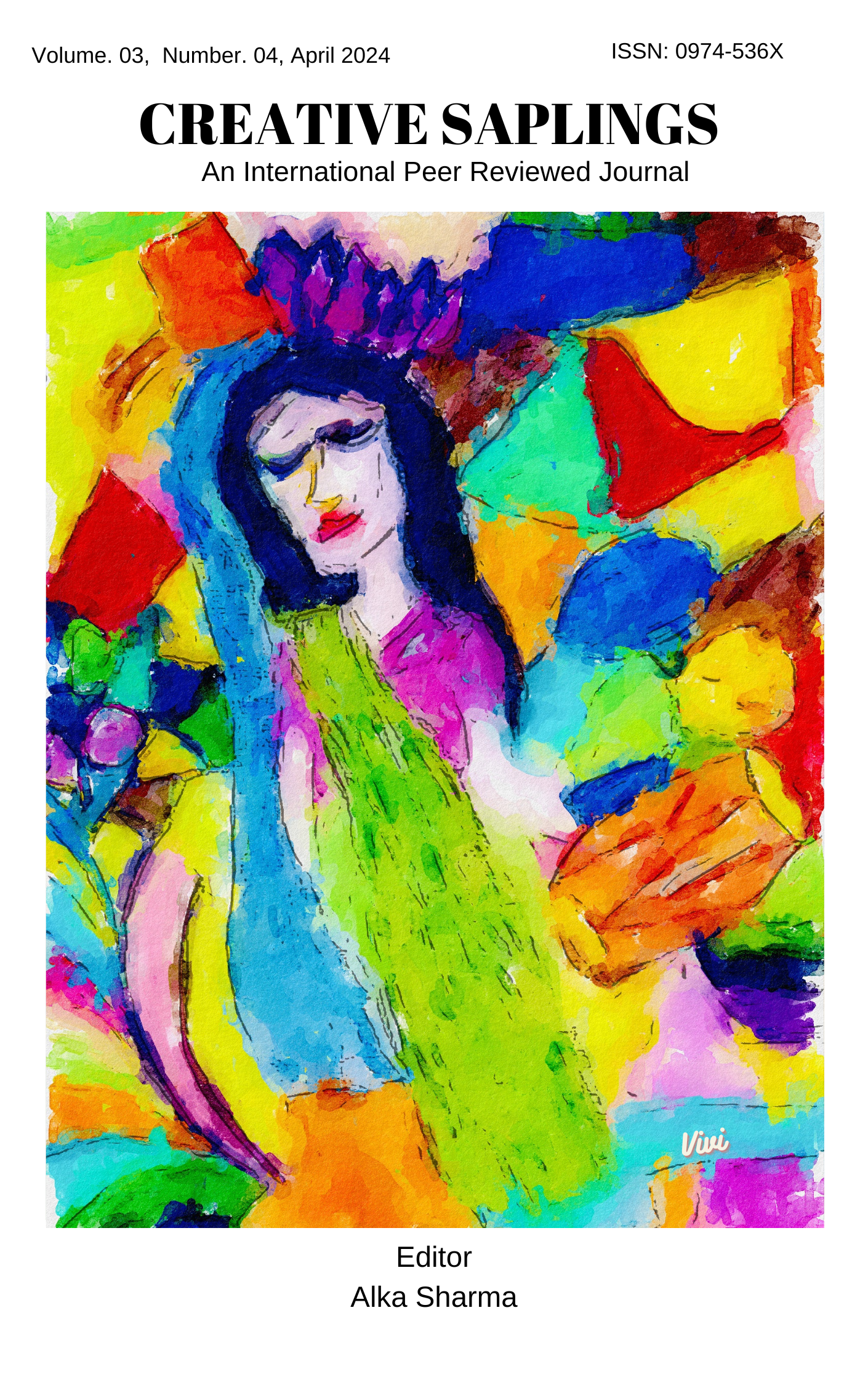Reimagining Women’s Freedom and Rights: A Study of Draupadi’s Portrayal in Chitra Banerjee Divakaruni’s The Palace of Illusions
DOI:
https://doi.org/10.56062/gtrs.2024.3.4.564Keywords:
Chitra Banerjee Divakaruni, The Palace of Illusions, Mahabharatha, Paanchali, Draupadi.Abstract
The heroine of the Hindu epic Mahabharatha, Draupadi, speaks out on the value of women's liberation and rights in a patriarchal society. The narrative of Draupadi, the fire-born princess, is told in the book The Palace of Illusions, which also highlights Chitra Banerjee Divakaruni's significant contribution to the portrayal of women as strong, brave, and resolute individuals who have the ability to alter history. It portrays the predicament of women in antiquity and highlights their bravery and will to lead fulfilling lives. The female characters in Divakarui are fearless, self-assured, and driven to fulfil their life's ambitions. She has the ability to make history that people remember for years to come. In her works, she has given women a more prominent position. The females characters are represented as equals to men in the patriarchal society. As seen in the story, women have a variety of roles in their life, including that of daughter, wife, mother, sister, and friend. The novel The Palace of Illusions sheds insight on the reasons for the pain and difficulties faced by female characters, in contrast to the epic Mahabharata. It draws attention to their significance in household life and helps people realise that they are both a part of earthly events and the great battle's forerunner. Chitra Banerjee breaks the taboo of all the powerful female characters in The Palace of Illusions, whose oppression and quiet gave them the resolve to oppose the systems that weigh down their sense of self. As a result, one of the most well-known female figures from ancient India is Draupadi.
Downloads
References
Bibliography:
Primary Source:
Divakaruni, Chitra Banerjee. The Palace of Illusions. Picador, 2009.
Secondary Source:
Agarwal, Beena. “The Palace of Illusions: A Saga of Female Voices.” Chitra Banerjee Divakarui: A New Voice in Indian English Fiction, Authorspress, 2016, pp. 104- 129.
Badrinath, Chaturvedi. “The Women of Mahabharata the Question of Truth.” Orient Blackswan, 2008.
Bora, Prerona. “Recreating Draupadi: A Study of Chitra Banerjee Divakaruni’s The Palace of Illusions.” SMART MOVES JOURNAL IJELLH, vol. 9, no. 5, 2021, pp. 297–308., doi:10.24113/ijellh.v9i5.11067.
Challa, Krishnaveer Abhishek. “The Role of Women in Indian Epic Literature.” IJELLH, vol. 3, no. X, 2015.
Chayanika Roy. “Reversing the Gaze: Subversion and Re-Interpretation of Mythical Stereotypes in Chitra Banerjee Divakaruni’s The Palace of Illusions.” The Creative Launcher, vol. 6, no. 2, 2021, pp. 113–118., doi:10.53032/tcl.2021.6.2.16.
Chitra Banerjee Divakaruni: A Critical Spectrum. India, Yking Books, 2017.
Critical Perspectives on Chitra Banerjee Divakaruni: Feminism and Diaspora. United States, Lexington Books, 2022.
Dhakal, Sabitri. “Chitra Banerjee Divakaruni’s The Palace of Illusions: Challenging a Patriarchal Domain.” KMC Research Journal, vol. 1, no. 1, 2017, pp. 9–17., doi:10.3126/kmcrj.v1i1.28239.
Gupta, Deepti, and Sumeet Brar. “Women in Diaspora, Stranded on the No-Man’s Land: A Study of Selected Works of Chitra Banerjee Divakaruni.” The English Paradigm in India, 2017, pp. 197–204., doi:10.1007/978-981-10-5332-0_14.
Gupta, Deepti, and Sumeet Brar. “Women in Diaspora, Stranded on the No-Man’s Land: A Study of Selected Works of Chitra Banerjee Divakaruni.” The English Paradigm in India, 2017, pp. 197–204., doi:10.1007/978-981-10-5332-0_14.
Liu, Daiqiong. “The Female Fidelity in the Perspective of Ecological Feminism: Rebellious Zhu Mu and Restrained Penelope - Based on Gesar Epics and Homeric Epics.” Proceedings of the 2017 2nd International Conference on Education, Sports, Arts and Management Engineering (ICESAME 2017), 2017, doi:10.2991/icesame-17.2017.31.
Madan, Anuja. “Hindu Mythology in Indian Comics and Animations for Young People, 2000-2015.” University Of Florida, 2016.
M., Ambili. “The Concept of Liberation in Chitra Banerjee Divakaruni’s The Palace of Illusions.” SMART MOVES JOURNAL IJELLH, vol. 8, no. 4, 2020, p. 107., doi:10.24113/ijellh.v8i4.10527.
Mukhoty, Ira. Heroines: Powerful Indian Women of Myth & History. India, Aleph, 2017.
Nada, Annisa Qothrine. “Oppression experienced by female characters in Chitra Banerjee Divakaruni's The Forest of Enchantments.” Undergraduate thesis, Universitas Islam Negeri Maulana Malik Ibrahim, 2021.
Narayanan, Renuka. “Review: The Palace of Illusions.” Hindustan Times, 13 Apr. 2008.
Prabhakar, Vani. Gender Violence: Women Victims in Man’s World. Wisdom Press, 2012.
Peiser, Megan. “Reviewing Women: Women Reviewers on Women Novelists.” Women's Periodicals and Print Culture in Britain, 1690-1820s, 2018, doi:10.3366/edinburgh/9781474419659.003.0016.
Rao, Anupama. “Afterword: An Awkward Relationship: Men and Feminism.” Men and Feminism in India, 2018, pp. 250–256., doi:10.4324/9781351048248-14.
Ray, Samrat. “The Forest of Enchantments (Chitra Banerjee Divakaruni).” Journal of Medical Evidence, vol. 2, no. 2, 2021, p. 198., doi:10.4103/jme.jme_69_21.
Reddy. V, Narayana, Vijaya Kumar.S and Nalini,B. Women in Development: Challenges and Achievements. Serials Publications, 2005.
Srinath, Archana. “The Palace of Illusions - Metaphor for Life.” The Journal of Indian Writing in English, vol. 38, no. 2, Jul. 2010, pp. 34-38.
Shrivastava, Priyanka. Cross-cultural Perspective and Sisterhood in the Fiction of Chitra Banerjee Divakaruni. India, Sarup Book Publishers (P) Limited, 2017.
Simran Agarwal, Simran Agarwal. “Ms. Draupadi Kuru by Trisha Das Juxtaposed against the Draupadi of the Palace of Illusions by Chitra Banerjee Divakaruni.” International Journal of English and Literature, vol. 10, no. 4, 2020, pp. 1–8., doi:10.24247/ijelaug20201.
The Cultural Heritage of India: Itihasas, Puranas, Dharma and Other Sastras. The Ramakrishna Mission Institute of Culture, 1962.
The Indian Family in the Change and Challenge of the Seventies. Sterling Publishers, 1972.
Downloads
Published
Issue
Section
License
Copyright (c) 2024 Uma Maheswary

This work is licensed under a Creative Commons Attribution-NonCommercial 4.0 International License.





